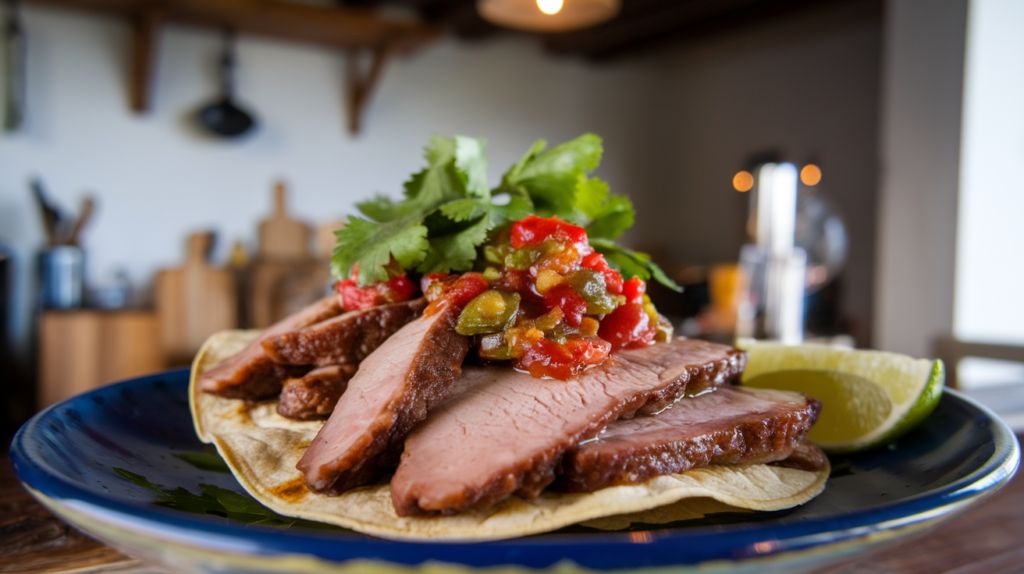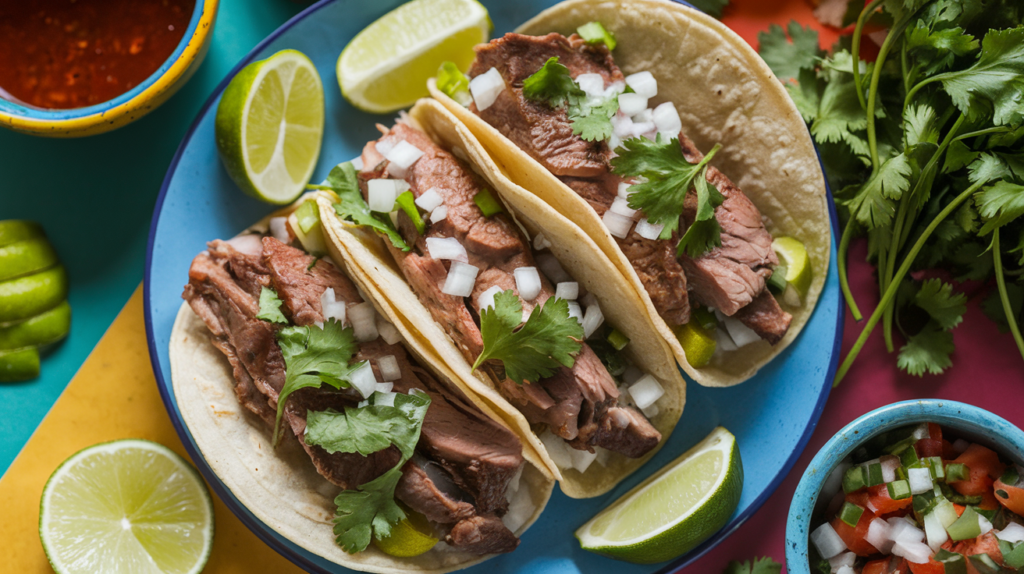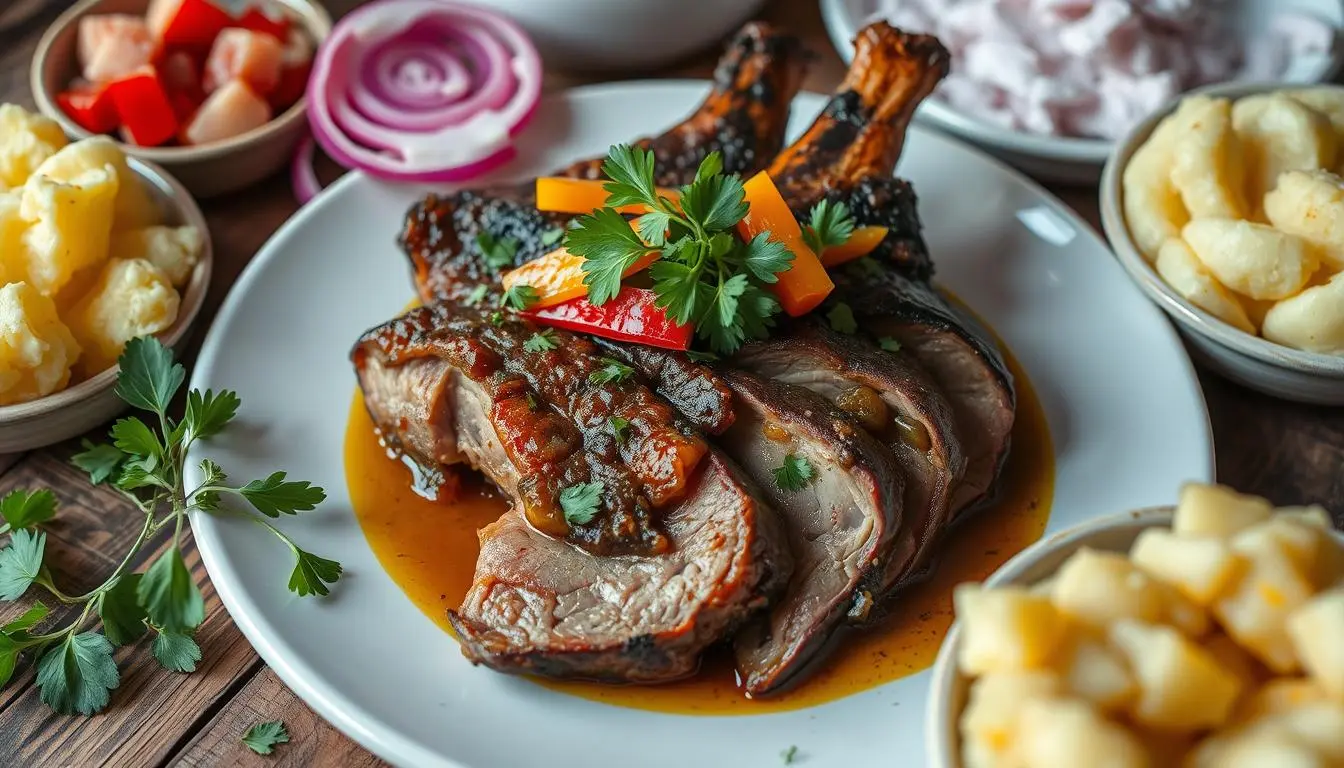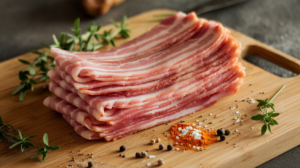Cow Tongue Recipe
Have you ever wondered what it’s like to try cow tongue? It’s a special cut of meat in many cultures, known for its unique texture and flavor. As a food lover, I’ve always been curious about cooking a cow tongue dish. Today, I’m excited to share my favorite recipe with you.
In this guide, you’ll learn how to make this affordable ingredient into a tender, flavorful dish. You’ll find out how to simmer it or use a pressure cooker for quick results. Plus, you’ll get tips on serving, storing, and fixing any issues to make your cow tongue recipe a hit.
No matter your cooking expertise, this cow tongue recipe is an excellent choice. It’s sure to wow your loved ones. So, let’s start exploring the delicious world of cow tongue recipe. Get ready to enjoy its rich, tender flavors that have delighted people for years.

Table of Contents
Understanding Beef Tongue and Its Culinary Heritage
cow tongue recipe, also known as lengua guisada in Mexican cuisine, is a special cut of meat. It has been enjoyed by food lovers for centuries. This part of the cow offers a unique taste that makes it stand out from other beef cuts.
What Exactly is Beef Tongue?
Beef tongue is a thick, muscular organ from cows. It tastes rich and beefy, and becomes tender when cooked right. It’s a key ingredient in many cuisines, especially in Mexican, Jewish, and European cooking.
Cultural Significance in Different Cuisines
In Mexican cuisine, lengua guisada or braised beef tongue is a favorite dish. It’s simmered with spices, onions, and garlic, making it flavorful and tender. Jewish cuisine also uses beef tongue in dishes like gehakte tsung, where it’s pickled and then cooked.
Nutritional Benefits of Cow Tongue
Beef tongue is not just tasty but also very nutritious.High in protein, it offers all the essential amino acids necessary for optimal health. It’s also full of vitamins and minerals like vitamin B12, iron, zinc, and selenium. Adding beef tongue to your meals can boost your health and well-being.
“Beef tongue is a culinary gem that deserves more recognition. When cooked with care, it transforms into a tender, flavorful delight that can elevate any meal.”
Essential Ingredients for Cow Tongue Recipe
cooking beef tongue To make a delicious cow tongue recipe like lengua en salsa, you need the right ingredients. The main ingredient is the beef tongue. You’ll need a 2-3 pound beef tongue, found at butchers or specialty stores.
For seasoning, you’ll need kosher salt, black pepper, dried bay leaves, whole peppercorns, and whole allspice. These add deep, savory flavors. For a mushroom-onion sauce, you’ll need butter, onions, mushrooms, beef broth, and cornstarch. Garlic cloves can also add to the flavor.
Whether you’re making a traditional cow tongue recipe or a modern lengua en salsa recipe, these ingredients are key. They ensure your dish is full of authentic taste and texture.
Preparing Your Beef Tongue for Cooking
Getting your beef tongue ready is key. First, rinse it well under cool water. You might see small black spots, but they’re normal and safe.
Cleaning and Trimming Tips
Trim off any extra fat or tough parts from the tongue’s base.It improves the cooking process and enhances its softness. Be careful not to hurt the meat while trimming.
Pre-cooking Preparations
- Check the tongue for any tough or off-color parts and remove them.
- Wipe the tongue dry with paper towels to get it ready for cooking.
- Soaking the tongue in water for 30 minutes to an hour can help clean it further.
Choose a high-quality, grass-fed beef tongue.It should be free of hormones, antibiotics, and genetically modified organisms.This ensures the best taste and texture. Tongue is becoming more popular for its rich flavor and tender feel.
With a bit of care, your beef tongue is ready for cooking. Whether you’re braising it or using a pressure cooker, the right prep is crucial. It unlocks the tongue’s full flavor and texture.
Traditional Simmering Method
The traditional simmering method is a classic way to make delicious braised cow tongue or lengua guisada. It involves cooking the tongue in a large pot with water and spices for 3-4 hours. This slow cooking makes the tongue tender and flavorful.
- Start by putting the beef tongue in a big pot and covering it with water. Heat the water until it boils.
- Once boiling, lower the heat to medium-low. Let the tongue simmer gently. Remove any foam that rises to the surface in the first 30 minutes.
- Add spices like whole peppercorns, bay leaves, and garlic cloves to the pot. This adds great flavors to the tongue.
- Flip the tongue periodically to cook it evenly on all sides. This ensures it stays tender all over.
- After 3-4 hours, the tongue should be very tender. Use a meat thermometer to check if it’s at 160°F (71°C).
It may take longer than other methods, but it’s well worth the effort. The slow cooking tenderizes the tongue, making it soft and full of flavor.
| Ingredient | Quantity |
| Beef Tongue | 1 large or 3 pork tongues |
| Water | 4 quarts |
| Salt | 250g |
| Sugar (optional) | 100g |
| Peppercorns | 1 tablespoon |
| Yellow Mustard Seeds | 1 tablespoon |
| Allspice Berries | 3 |
| Bay Leaves | 2 |
| Garlic, crushed | 1 head |
This traditional method is a beloved way to make braised cow tongue or lengua guisada. It results in a dish that is tender and full of flavor, sure to please your taste buds.

Pressure Cooker Method for Quick Results
If you’re in a rush, the pressure cooker method is perfect. It cooks your beef tongue dish faster. You get tender, flavorful results without spending hours in the kitchen.
Time and Temperature Guidelines
For a 2-pound beef tongue, cook for about 45 minutes in a pressure cooker. A 1-pound tongue takes 40 minutes. Just put the tongue in, add water, salt, and ginger, then seal and cook. The high pressure tenderizes the tongue quickly.
Safety Considerations
- Always consult the manufacturer’s manual for the correct usage of your pressure cooker.
- Allow the pressure to release naturally after cooking, as quick release can cause the hot liquid to spurt out.
- Use caution when removing the lid, as the escaping steam can cause burns.
- Ensure the pressure cooker is in good working order and the gasket is properly sealed before use.
The pressure cooker method is ideal for a beef tongue dish or cow tongue recipe when you’re in a hurry. It takes just over an hour to make a delicious, tender beef tongue.
Creating the Perfect Mushroom-Onion Sauce
Make your lengua en salsa recipe even better with a tasty mushroom-onion sauce. This sauce pairs perfectly with the tender Mexican beef tongue. It adds a rich flavor that matches the meat’s unique texture.
Begin by cooking 2 diced onions and 2 minced garlic cloves in 2 tablespoons of butter. Cook them until they’re soft and clear, about 5 minutes. Then, add 1 cup of sliced mushrooms and cook for another 5 minutes. Stir them occasionally until they’re lightly browned.
Now, pour in 4 cups of beef broth and let it simmerGive it 10-15 minutes of cooking time to enhance the flavor fusion.To thicken, mix 2 tablespoons of cornstarch with 1/4 cup of cold water. Slowly add this to the sauce and cook for 5 more minutes until it’s thick enough.
Finally, add 1/2 cup of heavy cream and season with 1 teaspoon of salt, 1/2 teaspoon of paprika, and black pepper. Taste and adjust the seasoning to get the perfect flavor for your lengua en salsa recipe.
By following these steps, you’ll get a delicious mushroom-onion sauce. It will make your Mexican beef tongue dish unforgettable. Serve the tongue with the sauce for a meal that’s sure to be remembered.
How to Properly Peel and Slice Cooked Tongue
After cooking your beef tongue, it’s time to peel and slice it. This might seem hard, but it’s easy with the right steps. Whether you’re making beef tongue tacos or ox tongue stew, learning to peel and slice is crucial.
Step-by-Step Peeling Guide
Remove the cooked beef tongue from the liquid and transfer it to a cutting board. It should be warm, which helps with peeling. With a sharp knife, carefully remove the tough outer layer from the tongue. Be gentle, as the meat is soft.
After removing the outer layer, you’ll find the tender, juicy inside of the tongue.
Slicing Techniques for Different Serving Styles
- For beef tongue tacos, cut the tongue into thin pieces.This makes the tacos both delicious and easy to enjoy.
- For ox tongue stew, cut the tongue into bigger chunks. They’ll stay firm in the stew.
- For sandwiches or other dishes, slice the tongue into thin strips. This looks good and is uniform.
When slicing, think about the texture and thickness. You want to show off the tongue’s tenderness and make it look great.
“Proper peeling and slicing of the cooked beef tongue is essential for maximizing its taste and texture. With a bit of care and attention, you can transform this often overlooked ingredient into a star of the show.”
Serving Suggestions and Accompaniments
With its versatility, beef tongue can be enjoyed in numerous creative ways. Whether you prefer it hot or cold, there are plenty of serving suggestions and accompaniments to enhance your culinary experience. Here are some ideas to help you make the most of this flavorful cut of meat:
Serving Suggestions
- Serve the beef tongue barbacoa hot, sliced, and drizzled with a rich mushroom-onion sauce. Pair it with creamy mashed potatoes or a side of roasted vegetables for a comforting meal.
- Use the smoked beef tongue in tacos, burritos, or tostadas, topping it with your favorite salsa verde, diced onions, and a squeeze of lime.
- Slice the cooled beef tongue and layer it on sandwiches or burgers, adding a dollop of horseradish sauce or Dijon mustard for a zesty kick.
Accompaniments
- Horseradish Sauce: The sharp, pungent flavor of horseradish complements the richness of the beef tongue beautifully.
- Pickled Vegetables: Tangy pickled onions, carrots, or peppers can provide a refreshing contrast to the tender, succulent tongue.
- Mustard: Offer a variety of mustards, including Dijon, whole-grain, or spicy, to let your guests customize their flavors.
The versatility of beef tongue allows you to explore various culinary traditions and serving styles. Experiment with different accompaniments and preparations to discover your personal preference and unlock the full potential of this unique and nutritious cut of meat.
| Serving Suggestion | Accompaniment | Cuisine |
| Beef Tongue Barbacoa | Mushroom-Onion Sauce, Mashed Potatoes | Mexican |
| Smoked Beef Tongue Tacos | Salsa Verde, Diced Onions, Lime | Mexican |
| Beef Tongue Sandwiches | Horseradish Sauce, Dijon Mustard | American |
“Beef tongue is a prized delicacy that deserves recognition and celebration. With its unique texture and rich flavor, it opens up a world of culinary possibilities.”
Storage and Leftover Ideas
Your tasty cow tongue recipe or beef tongue dish can stay fresh for 3-4 days in the fridge. To keep it safe and delicious, follow these storage tips.
Refrigeration Guidelines
Let the beef tongue cool down completely after cooking. Then, put the tongue and any leftover sauce or gravy in separate airtight containers. This keeps the flavor and texture great when you reheat it. Make sure to chill the tongue and sauce within 2 hours of cooking.
Freezing Methods
Freezing is a great way to keep your beef tongue longer. Slice or chunk the cooked tongue and put it in a freezer-safe container or bag.Freeze it for up to 3 months, and thaw it overnight in the fridge before reheating.
Freeze the extra sauce or gravy too. This makes reheating and serving with the thawed tongue quick and easy.
Be creative with your cow tongue recipe leftovers! From tacos to sandwiches, stews to hash, the tongue is perfect for all—find new ways to enjoy each bite.
Troubleshooting Common Issues
Cooking lengua guisada or braised cow tongue can have some common problems. But, with the right tips, you can make a delicious dish every time. We’ll help you solve issues like tough meat, peeling problems, and sauce separation.
Tough Tongue Meat
If your lengua guisada is tough, it might not have cooked long enough. The secret to tender tongue is cooking it slowly. Make sure it cooks for at least 3-4 hours to soften the meat.
Peeling Challenges
Peeling the cooked tongue can be hard. Clean the tongue well before cooking and blanch it briefly. This makes peeling easier after it’s cooked.
Sauce Separation
If your sauce separates, don’t panic.Whisk in a touch of flour or cornstarch to thicken. This will help the sauce stay smooth. Keep stirring on low heat until it’s creamy again.
Overcooking and Undercooking
It can be challenging to get the cooking time perfect. If it’s too tough, try shredding it and adding it to a stew. If it’s still hard, just keep cooking until it’s tender.
By tackling these common problems, you’ll get better at making braised cow tongue. Your lengua guisada will impress everyone.
Conclusion
Learning to make a delicious cow tongue recipe is a fun journey. This often-overlooked meat has lots of flavor and texture. It’s also rich in cultural history, making it a great addition to your cooking skills.
You can cook the tongue in a pot or use a pressure cooker for quicker results. Either way, you’ll get a tender, juicy dish. You can turn it into tacos, stews, or casseroles. Cow tongue is incredibly versatile.
Trying cow tongue also supports sustainable eating. It’s part of the growing trend of using the whole animal. This not only brings unique flavors to your table but also helps the environment.
FAQ
What is beef tongue and what is its cultural significance?
Beef tongue is a part of a cow, known for its rich taste and soft texture. It’s loved in many cuisines, like Mexican and Jewish cooking. It holds a special place in different food traditions.
What are the nutritional benefits of cow tongue?
Cow tongue offers a healthy dose of protein, vitamins, and minerals. It’s a healthy meat that can add variety to your diet.
What are the key ingredients for a basic cow tongue recipe?
For a simple cow tongue recipe, you need a 2-3 pound tongue, kosher salt, and black pepper. Also, dried bay leaves, whole peppercorns, and whole allspice are key. For a mushroom-onion sauce, you’ll need butter, onions, mushrooms, beef broth, and cornstarch.
How do I properly prep beef tongue before cooking?
First, rinse the tongue well. If it has black spots, don’t worry, they’re normal. Clean the tongue, trim fat, and get it ready for cooking.
How do I make a mushroom-onion sauce to serve with the beef tongue?
To make a tasty sauce, cook onions and mushrooms, then add beef broth. Thicken it with cornstarch.
How do I properly peel and slice the cooked beef tongue?
Peel the tongue while it’s still warm. This section shows how to peel it safely and effectively. It also covers slicing techniques for different dishes, like sandwiches or stews.
What are the best methods for serving and storing cooked beef tongue?
You can serve the cooked tongue hot with gravy and potatoes, or cold in tacos and sandwiches. Store it in the fridge for 3-4 days or freeze for up to three months. This section gives storage and reheating tips.
What are some common issues that may arise when cooking beef tongue, and how can I troubleshoot them?
This section talks about common problems like tough meat or sauce separation. It offers solutions and tips for a successful dish, including adjusting cooking times and temperature control.
There are no reviews yet. Be the first one to write one.







